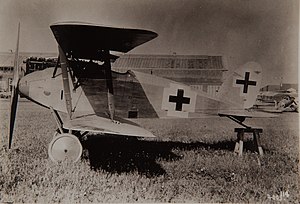
The Fokker D.VII was a German World War I fighter aircraft designed by Reinhold Platz of the Fokker-Flugzeugwerke. Germany produced around 3,300 D.VII aircraft in the second half of 1918. In service with the Luftstreitkräfte, the D.VII quickly proved itself to be a formidable aircraft. The Armistice ending the war specifically required, as the fourth clause of the "Clauses Relating to the Western Front", that Germany was required to surrender all D.VIIs to the Allies. Surviving aircraft saw much service with many countries in the years after World War I.
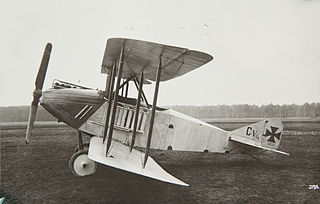
The AEG C.V was a prototype two-seat biplane reconnaissance aircraft of World War I. Designed to use a more powerful engine than previous AEG C-class reconnaissance aircraft, results were disappointing enough that further development was cancelled.

The AEG Dr.I was a triplane fighter of World War I, based on the D.I. Only a single prototype was built and its poor performance meant that no production ensued. The Dr.I was a Dreidecker (triplane) variant of the D.I and had been inspired by a Sopwith Triplane that had been captured intact. A number of proposals for fighters with comparable characteristics were put forward, and AEG's contribution to the program appeared in October 1917. Other than the triple wing it was a D.I, the aircraft had the same fuselage, engine and twin gun armament of its earlier brethren.
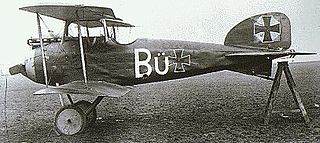
The Albatros D.I was a German fighter aircraft used during World War I. Although its operational career was short, it was the first of the Albatros D types which equipped the bulk of the German and Austrian fighter squadrons (Jagdstaffeln) for the last two years of the war.

The Albatros D.IV was an experimental German fighter aircraft built and tested during World War I.

The Albatros D.V is a fighter aircraft of the German aircraft manufacturer Albatros Flugzeugwerke. It was the final development of the Albatros D.I family and the last Albatros fighter to see operational service with the Luftstreitkräfte during the First World War.

The Fokker D.I was a development of the D.II fighter. The D.I was also flown in Austro-Hungarian service as a fighter trainer aircraft under the designation B.III. Confusing the matter further, both the D.II and D.I arrived at the Front in German service at similar times, in July–August 1916. The main designer was Martin Kreutzer.

The Pfalz D.III was a fighter aircraft used by the Luftstreitkräfte during the First World War. The D.III was the first major original design from Pfalz Flugzeugwerke. Though generally considered inferior to contemporary Albatros and Fokker fighters, the D.III was widely used by the Jagdstaffeln from late 1917 to mid-1918. It continued to serve as a training aircraft until the end of the war.
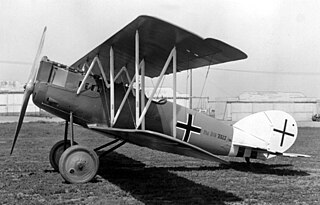
The Pfalz D.XII was a German fighter aircraft built by Pfalz Flugzeugwerke. Designed by Rudolph Gehringer as a successor to the Pfalz D.III, the D.XII entered service in significant numbers near the end of the First World War. It was the last Pfalz aircraft to see widespread service. Though the D.XII was an effective fighter aircraft, it was overshadowed by the highly successful Fokker D.VII.

The Mercedes D.III, or F1466 as it was known internally, was a six-cylinder SOHC valvetrain liquid-cooled inline aircraft engine built by Daimler and used on a wide variety of German aircraft during World War I. The initial versions were introduced in 1914 at 120 kW (160 hp), but a series of changes improved this to 130 kW (170 hp) in 1917, and 130 kW (180 hp) by mid-1918. These later models were used on almost all late-war German fighters, and its only real competition, the BMW III, was available only in very limited numbers. Compared to the Allied engines it faced, the D.III was generally outdated.

The Albatros W.4 was a German floatplane derivative of the Albatros D.I fighter with new wing and tail surfaces of greater span than the D.I. One hundred eighteen examples were built between June 1916 and December 1917. The aircraft operated in the North Sea and Baltic theatres and later served as training aircraft.
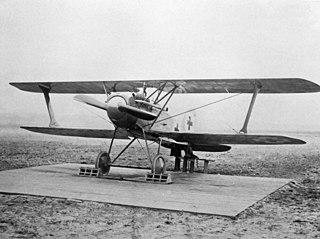
The Albatros D.X was a German prototype single-seat fighter biplane developed in 1918 in parallel with the Albatros D.IXme

The Albatros Dr.II was a German prototype single-seat fighter triplane, the sole example of which flew in the spring of 1918. It was similar in many respects to the D.X biplane, employing among other features the same 145 kW (195 hp) Benz Bz.IIIbo engine and twin 7.92 mm (.312 in) machine guns.

The AGO C.VIII was a German reconnaissance aircraft built by AGO Flugzeugwerke during World War I.

The Hannover CL.III was a German military aircraft of World War I. It was a two-seat multi-role aircraft, primarily used as a ground attack machine. Like the other Hannover "light-C-class", or "CL" designated aircraft designed by Hermann Dorner, it included an unusual biplane tail, allowing for a greater firing arc for the tail gunner. Until the introduction of the aircraft, such tails had only been used on larger aircraft.

The Albatros G.I,, was a four-engined German biplane bomber of World War I.

The LFG Roland D.XV was a World War I German single seat fighter aircraft, ordered as a test-bed for engine comparisons. It was distinguished from earlier Roland biplane designs by the elimination of flying wires. Two later aircraft, also called LFG Roland D.XV, were completely different designs with slab sided fuselages.

The Rumpler C.X, produced under the company designation Rumpler 8C 14, was a German two-seat observation aircraft. It was developed from the earlier Rumpler 8C 13 prototype by Rumpler in early 1918. The prototype had a similar wing design to the Rumpler C.VII, powered by a 260 hp (194 kW) Mercedes D.IVa engine and was later powered by a 240 hp (179 kW) Maybach Mb.IVa. The C.X had the highest top speed and service ceiling of all German C-type aircraft and an order was placed for the aircraft in August 1918, but few were built and tested before the war ended.

The Zeppelin-Lindau CS.I was a German single-engined reconnaissance seaplane with a low-wing monoplane layout.
The NFW E.II was a fighter aircraft built in Germany during World War I.
